Zero-Waste Management and Sustainable Consumption: A Comprehensive Bibliometric Mapping Analysis
Abstract
1. Introduction
2. Theoretical Framework
2.1. Zero-Waste Management
2.2. Sustainable Consumption and Development
2.3. Bibliometric
2.4. Bibliometric Research in Waste Management and Sustainable Consumption
3. Methodology
3.1. Measures
3.2. Sample and Process
4. Results and Discussion
4.1. General Structure of Publication and Citation
4.2. Keywords
4.3. Leading Most Cited Papers
4.4. Leading Journal
4.5. Leading Authors
4.6. Leading Universities Affiliation
4.7. Leading Regions
5. Conclusions
5.1. Implications
5.2. Limitations and Future Research
Author Contributions
Funding
Institutional Review Board Statement
Informed Consent Statement
Data Availability Statement
Conflicts of Interest
References
- Awasthi, A.K.; Cheela, V.R.S.; D’Adamo, I.; Iacovidou, E.; Islam, M.R.; Johnson, M.; Miller, T.R.; Parajuly, K.; Parchomenko, A.; Radhakrishan, L.; et al. Zero waste approach towards a sustainable waste management. Resour. Environ. Sustain. 2021, 3, 100014. [Google Scholar] [CrossRef]
- Mesjasz-Lech, A. Reverse logistics of municipal solid waste—Towards zero waste cities. Transp. Res. Procedia 2019, 39, 320–332. [Google Scholar] [CrossRef]
- Gharfalkar, M.; Court, R.; Campbell, C.; Ali, Z.; Hillier, G. Analysis of waste hierarchy in the European waste directive 2008/98/EC. Waste Manag. 2015, 39, 305–313. [Google Scholar] [CrossRef]
- Singh, A.; Sushil. Developing a conceptual framework of waste management in the organizational context. Manag. Environ. Qual. Int. J. 2017, 28, 786–806. [Google Scholar] [CrossRef]
- Armindo, J.; Fonseca, A.; Abreu, I.; Toldy, T. Perceived importance of sustainability dimensions in the Portuguese metal industry. Int. J. Sustain. Dev. World Ecol. 2019, 26, 154–165. [Google Scholar] [CrossRef]
- Joseph, J.; Orlitzky, M.; Gurd, B.; Borland, H.; Lindgreen, A. Can business-oriented managers be effective leaders for corporate sustainability? A study of integrative and instrumental logics. Bus. Strat. Environ. 2018, 28, 339–352. [Google Scholar] [CrossRef]
- Szopik-Depczyńska, K.; Kędzierska-Szczepaniak, A.; Szczepaniak, K.; Cheba, K.; Gajda, W.; Ioppolo, G. Innovation in sustainable development: An investigation of the EU context using 2030 agenda indicators. Land Use Policy 2018, 79, 251–262. [Google Scholar] [CrossRef]
- Mura, M.; Longo, M.; Zanni, S. Circular economy in Italian SMEs: A multi-method study. J. Clean. Prod. 2020, 245, 118821. [Google Scholar] [CrossRef]
- Sustainability Plan. Available online: https://www.latrobe.edu.au/__data/assets/pdf_file/0005/554927/Sustainability-Plan-2013-2017.pdf (accessed on 14 September 2022).
- Olawumi, T.O.; Chan, D.W.M. A scientometric review of global research on sustainability and sustainable development. J. Clean. Prod. 2018, 183, 231–250. [Google Scholar] [CrossRef]
- Hopton, M.E.; Cabezas, H.; Campbell, D.; Eason, T.; Garmestani, A.S.; Heberling, M.T.; Karunanithi, A.T.; Templeton, J.J.; White, D.; Zanowick, M. Development of a multidisciplinary approach to assess regional sustainability. Int. J. Sustain. Dev. World Ecol. 2010, 17, 48–56. [Google Scholar] [CrossRef]
- Phillis, Y.A.; Andriantiatsaholiniaina, L.A. Sustainability: An ill-defined concept and its assessment using fuzzy logic. Ecol. Econ. 2001, 37, 435–456. [Google Scholar] [CrossRef]
- Sauvé, S.; Bernard, S.; Sloan, P. Environmental sciences, sustainable development and circular economy: Alternative concepts for trans-disciplinary research. Environ. Dev. 2016, 17, 48–56. [Google Scholar] [CrossRef]
- Schaltegger, S.; Burritt, R. Chapter 5: Corporate Sustainability. In The International Yearbook of Environmental and Resource Economics 2005/2006; Edward Elgar Publishing Limited: Cheltenham, UK, 2005. [Google Scholar]
- Murray, A.; Skene, K.; Haynes, K. The Circular Economy: An Interdisciplinary Exploration of the Concept and Application in a Global Context. J. Bus. Ethics 2017, 140, 369–380. [Google Scholar] [CrossRef]
- Ghisellini, P.; Cialani, C.; Ulgiati, S. A Review on Circular Economy: The Expected Transition to a Balanced Interplay of Environmental and Economic Systems. J. Clean. Prod. 2016, 114, 11–32. [Google Scholar] [CrossRef]
- Camilleri, M.A. Sustainable Production and Consumption of Food. Mise-en-Place Circular Economy Policies and Waste Management Practices in Tourism Cities. Sustainability 2021, 13, 9986. [Google Scholar] [CrossRef]
- Tamasiga, P.; Miri, T.; Onyeaka, H.; Hart, A. Food Waste and Circular Economy: Challenges and Opportunities. Sustainability 2022, 14, 9896. [Google Scholar] [CrossRef]
- Rodrigo-Ilarri, J.; Vargas-Terranova, C.-A.; Rodrigo-Clavero, M.-E.; Bustos-Castro, P.-A. Advances on the Implementation of Circular Economy Techniques in Rural Areas in Colombia under a Sustainable Development Framework. Sustainability 2021, 13, 3816. [Google Scholar] [CrossRef]
- Kirchherr, J.; Reike, D.; Hekkert, M. Conceptualizing the circular economy: An analysis of 114 definitions. Resour. Conserv. Recycl. 2017, 127, 221–232. [Google Scholar] [CrossRef]
- Kirchherr, J.; Piscicelli, L.; Bour, R.; Kostense-Smit, E.; Muller, J.; Huibrechtse-Truijens, A.; Hekkert, M. Barriers to the Circular Economy: Evidence from the European Union (EU). Ecol. Econ. 2018, 150, 264–272. [Google Scholar] [CrossRef]
- Aranda-Usón, A.; Portillo-Tarragona, P.; Scarpellini, S.; Llena-Macarulla, F. The progressive adoption of a circular economy by businesses for cleaner production: An approach from a regional study in Spain. J. Clean. Prod. 2020, 247, 119648. [Google Scholar] [CrossRef]
- Zaman, A.U. A comprehensive review of the development of zero waste management: Lessons learned and guidelines. J. Clean. Prod. 2015, 91, 12–25. [Google Scholar] [CrossRef]
- Zhang, S.; Tan, Q.; Xu, G.; Li, J. Unveiling characteristics and trend of zero waste research: A scientometric perspective. Environ. Sci. Pollut. Res. 2022, 29, 44391–44403. [Google Scholar] [CrossRef] [PubMed]
- Zupic, I.; Čater, T. Bibliometric methods in management and organization. Organ. Res. Methods 2015, 18, 429–472. [Google Scholar] [CrossRef]
- Waltman, L.; van Eck, N.J.; Noyons, E.C.M. A unified approach to mapping and clustering of bibliometric networks. J. Informetr. 2010, 4, 629–635. [Google Scholar] [CrossRef]
- Demirbas, A. Waste management, waste resource facilities and waste conversion processes. Energy Convers. Manag. 2011, 52, 1280–1287. [Google Scholar] [CrossRef]
- Villegas Pinuer, F.J.; Llonch Andreu, J.; Belbeze, P.L.; Valenzuela-Fernández, L. Waste Management. The Disconnection between Normative and SMEs Reality. Sustainability 2021, 13, 1787. [Google Scholar] [CrossRef]
- Mingaleva, Z.; Vukovic, N.; Volkova, I.; Salimova, T. Waste Management in Green and Smart Cities: A Case Study of Russia. Sustainability 2019, 12, 94. [Google Scholar] [CrossRef]
- Shekdar, A.V. Sustainable solid waste management: An integrated approach for Asian countries. Waste Manag. 2009, 29, 1438–1448. [Google Scholar] [CrossRef]
- Singh, S.; Ramakrishna, S.; Gupta, M.K. Towards zero waste manufacturing: A multidisciplinary review. J. Clean. Prod. 2017, 168, 1230–1243. [Google Scholar] [CrossRef]
- Ranjbari, M.; Saidani, M.; Shams Esfandabadi, Z.; Peng, W.; Lam, S.S.; Aghbashlo, M.; Quatraro, F.; Tabata-baei, M. Two decades of research on waste management in the circular economy: Insights from bibliometric, text mining, and content analyses. J. Clean. Prod. 2021, 314, 128009. [Google Scholar] [CrossRef]
- Chen, X.; Pang, J.; Zhang, Z.; Li, H. Sustainability Assessment of Solid Waste Management in China: A Decoupling and Decomposition Analysis. Sustainability 2014, 6, 9268–9281. [Google Scholar] [CrossRef]
- Zurbrügg, C.; Caniato, M.; Vaccari, M. How Assessment Methods Can Support Solid Waste Management in Developing Countries—A Critical Review. Sustainability 2014, 6, 545–570. [Google Scholar] [CrossRef]
- Gallego Dávila, J.; Azcárate, J.; Kørnøv, L. Strategic Environmental Assessment for development programs and sustainability transition in the Colombian post-conflict context. Environ. Impact Assess. Rev. 2019, 74, 35–42. [Google Scholar] [CrossRef]
- Mori, K.; Christodoulou, A. Review of sustainability indices and indicators: Towards a new City Sustainability Index (CSI). Environ. Impact Assess. Rev. 2012, 32, 94–106. [Google Scholar] [CrossRef]
- Balkema, A.J.; Preisig, H.A.; Otterpohl, R.; Lambert, F.J.D. Indicators for the sustainability assessment of wastewater treatment systems. Urban Water 2002, 4, 153–161. [Google Scholar] [CrossRef]
- Li, H.; Nitivattananon, V.; Li, P. Developing a Sustainability Assessment Model to Analyze China’s Municipal Solid Waste Management Enhancement Strategy. Sustainability 2015, 7, 1116–1141. [Google Scholar] [CrossRef]
- Ruggerio, C.A. Sustainability and sustainable development: A review of principles and definitions. Sci. Total. Environ. 2021, 786, 147481. [Google Scholar] [CrossRef]
- Alvarado-Herrera, A.; Bigne, E.; Aldas-Manzano, J.; Curras-Perez, R. A Scale for Measuring Consumer Perceptions of Corporate Social Responsibility Following the Sustainable Development Paradigm. J. Bus. Ethics 2017, 140, 243–262. [Google Scholar] [CrossRef]
- The Concept of Sustainable Development: Definition and Defining Principles. Available online: https://sustainabledevelopment.un.org/content/documents/5839GSDR%202015_SD_concept_definiton_rev.pdf (accessed on 26 September 2022).
- Spaiser, V.; Ranganathan, S.; Swain, R.B.; Sumpter, D.J.T. The sustainable development oxymoron: Quantifying and modelling the incompatibility of sustainable development goals. Int. J. Sustain. Dev. World Ecol. 2017, 24, 457–470. [Google Scholar] [CrossRef]
- Wang, C.; Ghadimi, P.; Lim, M.K.; Tseng, M.-L. A literature review of sustainable consumption and production: A comparative analysis in developed and developing economies. J. Clean. Prod. 2018, 206, 741–754. [Google Scholar] [CrossRef]
- Valenzuela-Fernández, L.; Guerra-Velásquez, M.; Escobar-Farfán, M.; García-Salirrosas, E.E. Influence of COVID-19 on Environmental Awareness, Sustainable Consumption, and Social Responsibility in Latin American Countries. Sustainability 2022, 14, 12754. [Google Scholar] [CrossRef]
- United Nations Sustainable Consumption and Production. Available online: https://sustainabledevelopment.un.org/topics/sustainableconsumptionandproduction (accessed on 8 September 2022).
- Hosseinalizadeh, R.; Izadbakhsh, H.; Shakouri, G.H. A planning model for using municipal solid waste management technologies-considering Energy, Economic, and Environmental Impacts in Tehran-Iran. Sustain. Cities Soc. 2021, 65, 102566. [Google Scholar] [CrossRef]
- Kanhai, G.; Fobil, J.N.; Nartey, B.A.; Spadaro, J.V.; Mudu, P. Urban Municipal Solid Waste management: Modeling air pollution scenarios and health impacts in the case of Accra, Ghana. Waste Manag. 2021, 123, 15–22. [Google Scholar] [CrossRef]
- Hodgkinson, I.; Maletz, R.; Simon, F.-G.; Dornack, C. Mini-review of waste-to-energy related air pollution and their limit value regulations in an international comparison. Waste Manag. Res. J. Sustain. Circ. Econ. 2022, 40, 849–858. [Google Scholar] [CrossRef]
- Todorov, V.; Dimov, I. Innovative Digital Stochastic Methods for Multidimensional Sensitivity Analysis in Air Pollution Modelling. Mathematics 2022, 10, 2146. [Google Scholar] [CrossRef]
- de Medeiros, J.F.; Ribeiro, J.L.D. Environmentally sustainable innovation: Expected attributes in the purchase of green products. J. Clean. Prod. 2017, 142, 240–248. [Google Scholar] [CrossRef]
- Ritter, Á.M.; Borchardt, M.; Vaccaro, G.L.R.; Pereira, G.M.; Almeida, F. Motivations for promoting the consumption of green products in an emerging country: Exploring attitudes of Brazilian consumers. J. Clean. Prod. 2015, 106, 507–520. [Google Scholar] [CrossRef]
- Severo, E.A.; de Guimarães, J.C.F.; Henri Dorion, E.C. Cleaner production, social responsibility and eco-innovation: Generations’ perception for a sustainable future. J. Clean. Prod. 2018, 186, 91–103. [Google Scholar] [CrossRef]
- Dimov, I.; Maire, S.; Todorov, V. An unbiased Monte Carlo method to solve linear Volterra equations of the second kind. Neural Comput. Appl. 2022, 34, 1527–1540. [Google Scholar] [CrossRef]
- Broadus, R.N. Toward a definition of “bibliometrics”. Scientometrics 1987, 12, 373–379. [Google Scholar] [CrossRef]
- Suriyankietkaew, S.; Petison, P. A Retrospective and Foresight: Bibliometric Review of International Research on Strategic Management for Sustainability, 1991–2019. Sustainability 2019, 12, 91. [Google Scholar] [CrossRef]
- de Carvalho Araújo, C.; Salvador, R.; Moro Piekarski, C.; Sokulski, C.; de Francisco, A.; de Carvalho Araújo Camargo, S. Circular Economy Practices on Wood Panels: A Bibliographic Analysis. Sustainability 2019, 11, 1057. [Google Scholar] [CrossRef]
- Concari, A.; Kok, G.; Martens, P. A Systematic Literature Review of Concepts and Factors Related to Pro-Environmental Consumer Behaviour in Relation to Waste Management through an Interdisciplinary Approach. Sustainability 2020, 12, 4452. [Google Scholar] [CrossRef]
- Ferreira Gregorio, V.; Pié, L.; Terceño, A. A Systematic Literature Review of Bio, Green and Circular Economy Trends in Publications in the Field of Economics and Business Management. Sustainability 2018, 10, 4232. [Google Scholar] [CrossRef]
- Pritchard, A. Statistical Bibliography or Bibliometrics? J. Doc. 1969, 25, 349. [Google Scholar]
- Cancino, C.; Merigó, J.M.; Coronado, F.; Dessouky, Y.; Dessouky, M. Forty years of Computers & Industrial Engineering: A bibliometric analysis. Comput. Ind. Eng. 2017, 113, 614–629. [Google Scholar] [CrossRef]
- Bonilla, C.A.; Merigó, J.M.; Torres-Abad, C. Economics in Latin America: A bibliometric analysis. Scientometrics 2015, 105, 1239–1252. [Google Scholar] [CrossRef]
- Laengle, S.; Merigó, J.M.; Miranda, J.; Słowiński, R.; Bomze, I.; Borgonovo, E.; Dyson, R.G.; Oliveira, J.F.; Teunter, R. Forty years of the European Journal of Operational Research: A bibliometric overview. Eur. J. Oper. Res. 2017, 262, 803–816. [Google Scholar] [CrossRef]
- Sharma, B.; Boet, S.; Grantcharov, T.; Shin, E.; Barrowman, N.J.; Bould, M.D. The h-index outperforms other bibliometrics in the assessment of research performance in general surgery: A province-wide study. Surgery 2013, 153, 493–501. [Google Scholar] [CrossRef]
- Aguinis, H.; Glavas, A. What We Know and Don’t Know about Corporate Social Responsibility. J. Manag. 2012, 38, 932–968. [Google Scholar] [CrossRef]
- Podsakoff, P.M.; MacKenzie, S.B.; Podsakoff, N.P.; Bachrach, D.G. Scholarly Influence in the Field of Management: A Bibliometric Analysis of the Determinants of University and Author Impact in the Management Literature in the Past Quarter Century. J. Manag. 2008, 34, 641–720. [Google Scholar] [CrossRef]
- Andrade-Valbuena, N.A.; Valenzuela-Fernández, L.; Merigó, J.M. Thirty-five years of strategic management research. A country analysis using bibliometric techniques for the 1987–2021 period. Cuad. Gestión 2022, 22, 7–22. [Google Scholar] [CrossRef]
- Landström, H.; Harirchi, G.; Åström, F. Entrepreneurship: Exploring the knowledge base. Res. Policy 2012, 41, 1154–1181. [Google Scholar] [CrossRef]
- Fagerberg, J.; Fosaas, M.; Sapprasert, K. Innovation: Exploring the knowledge base. Res. Policy 2012, 41, 1132–1153. [Google Scholar] [CrossRef]
- Merigó, J.M.; Cancino, C.A.; Coronado, F.; Urbano, D. Academic research in innovation: A country analysis. Scientometrics 2016, 108, 559–593. [Google Scholar] [CrossRef]
- Valenzuela-Fernández, L.; Munoz Quezada, I.; Merigo, J.M. Mapping the most competitive journals in advertising research. A bibliometric analysis in a 25-year period. J. Glob. Sch. Mark. Sci. 2022, 32, 1–33. [Google Scholar] [CrossRef]
- Martínez-López, F.J.; Merigó, J.M.; Valenzuela-Fernández, L.; Nicolás, C. Fifty years of the European Journal of Marketing: A bibliometric analysis. Eur. J. Mark. 2018, 52, 439–468. [Google Scholar] [CrossRef]
- Gaviria-Marin, M.; Merigo, J.M.; Popa, S. Twenty years of the Journal of Knowledge Management: A bibliometric analysis. J. Knowl. Manag. 2018, 22, 1655–1687. [Google Scholar] [CrossRef]
- Pizarro, V.; Merigó, J.M.; Valenzuela, L.; Aciares, S. A Bibliometric Study of Key Journals in Corporate Social Responsibility. In Lecture Notes in Networks and Systems; Springer: Cham, Switzerland, 2022; pp. 205–216. [Google Scholar]
- de Bakker, F.G.A.; Groenewegen, P.; den Hond, F. A Bibliometric Analysis of 30 Years of Research and Theory on Corporate Social Responsibility and Corporate Social Performance. Bus. Soc. 2005, 44, 283–317. [Google Scholar] [CrossRef]
- Nicolas, C.; Valenzuela-Fernández, L.; Merigó, J.M. Research Trends of Marketing: A Bibliometric Study 1990–2017. J. Promot. Manag. 2020, 26, 674–703. [Google Scholar] [CrossRef]
- Vošner, H.B.; Kokol, P.; Bobek, S.; Železnik, D.; Završnik, J. A bibliometric retrospective of the Journal Computers in Human Behavior (1991–2015). Comput. Hum. Behav. 2016, 65, 46–58. [Google Scholar] [CrossRef]
- Ramos-Rodríguez, A.-R.; Navarro, J.R. Changes in the intellectual structure of strategic management research: A bibliometric study of theStrategic Management Journal, 1980–2000. Strat. Manag. J. 2004, 25, 981–1004. [Google Scholar] [CrossRef]
- Yu, D.; Xu, Z.; Antuchevičienė, J. Bibliometric Analysis of the Journal of Civil Engineering and Management between 2008 and 2018. J. Civ. Eng. Manag. 2019, 25, 402–410. [Google Scholar] [CrossRef]
- Merigó, J.M.; Gil-Lafuente, A.M.; Yager, R.R. An overview of fuzzy research with bibliometric indicators. Appl. Soft Comput. 2015, 27, 420–433. [Google Scholar] [CrossRef]
- Baumgartner, H.; Pieters, R. The Structural Influence of Marketing Journals: A Citation Analysis of the Discipline and its Subareas over Time. J. Mark. 2003, 67, 123–139. [Google Scholar] [CrossRef]
- Shi, K.; Zhou, Y.; Zhang, Z. Mapping the Research Trends of Household Waste Recycling: A Bibliometric Analysis. Sustainability 2021, 13, 6029. [Google Scholar] [CrossRef]
- Avilés-Palacios, C.; Rodríguez-Olalla, A. The Sustainability of Waste Management Models in Circular Economies. Sustainability 2021, 13, 7105. [Google Scholar] [CrossRef]
- Negrete-Cardoso, M.; Rosano-Ortega, G.; Álvarez-Aros, E.L.; Tavera-Cortés, M.E.; Vega-Lebrún, C.A.; Sánchez-Ruíz, F.J. Circular economy strategy and waste management: A bibliometric analysis in its contribution to sustainable development, toward a post-COVID-19 era. Environ. Sci. Pollut. Res. 2022, 29, 61729–61746. [Google Scholar] [CrossRef]
- Murgado-Armenteros, E.M.; Gutiérrez-Salcedo, M.; Torres-Ruiz, F.J.; Cobo, M.J. Analysing the conceptual evolution of qualitative marketing research through science mapping analysis. Scientometrics 2014, 102, 519–557. [Google Scholar] [CrossRef]
- Valenzuela Fernandez, L.M.; Nicolas, C.; Merigó, J.M.; Arroyo-Cañada, F.-J. Industrial marketing research: A bibliometric analysis (1990–2015). J. Bus. Ind. Mark. 2019, 34, 550–560. [Google Scholar] [CrossRef]
- Hirsch, J.E. An index to quantify an individual’s scientific research output. Proc. Natl. Acad. Sci. USA 2005, 102, 16569–16572. [Google Scholar] [CrossRef] [PubMed]
- Valenzuela-Fernández, L.; Merigó, J.M.; Nicolas, C. Universidades influyentes en investigación sobre orientación al mercado. Una visión general entre 1990 y 2014. Estud. Gerenc. 2017, 33, 221–227. [Google Scholar] [CrossRef]
- Blanco-Mesa, F.; Merigó, J.M.; Gil-Lafuente, A.M. Fuzzy decision making: A bibliometric-based review. J. Intell. Fuzzy Syst. 2017, 32, 2033–2050. [Google Scholar] [CrossRef]
- Baier-Fuentes, H.; Merigó, J.M.; Amorós, J.E.; Gaviria-Marín, M. International entrepreneurship: A bibliometric overview. Int. Entrep. Manag. J. 2019, 15, 385–429. [Google Scholar] [CrossRef]
- Alonso, S.; Cabrerizo, F.J.; Herrera-Viedma, E.; Herrera, F. h-Index: A review focused in its variants, computation and standardization for different scientific fields. J. Informetr. 2009, 3, 273–289. [Google Scholar] [CrossRef]
- Jiménez-García, M.; Ruiz-Chico, J.; Peña-Sánchez, A.R.; López-Sánchez, J.A. A Bibliometric Analysis of Sports Tourism and Sustainability (2002–2019). Sustainability 2020, 12, 2840. [Google Scholar] [CrossRef]
- Kessler, M.M. Bibliographic coupling between scientific papers. Am. Doc. 1963, 14, 10–25. [Google Scholar] [CrossRef]
- Mulet-Forteza, C.; Martorell-Cunill, O.; Merigó, J.M.; Genovart-Balaguer, J.; Mauleon-Mendez, E. Twenty five years of the Journal of Travel & Tourism Marketing: A bibliometric ranking. J. Travel Tour. Mark. 2018, 35, 1201–1221. [Google Scholar] [CrossRef]
- Small, H. Co-citation in the scientific literature: A new measure of the relationship between two documents. J. Am. Soc. Inf. Sci. 1973, 24, 265–269. [Google Scholar] [CrossRef]
- Wang, B.; Zhang, Q.; Cui, F. Scientific research on ecosystem services and human well-being: A bibliometric analysis. Ecol. Indic. 2021, 125, 107449. [Google Scholar] [CrossRef]
- Sehnem, S.; Queiroz, A.A.F.S.L.; Pereira, S.C.F.; Santos Correia, G.; Kuzma, E. Circular economy and innovation: A look from the perspective of organizational capabilities. Bus. Strat. Environ. 2021, 31, 236–250. [Google Scholar] [CrossRef]
- Martorell Cunill, O.; Socias Salvá, A.; Otero Gonzalez, L.; Mulet-Forteza, C. Thirty-fifth anniversary of the International Journal of Hospitality Management: A bibliometric overview. Int. J. Hosp. Manag. 2018, 78, 89–101. [Google Scholar] [CrossRef]
- Papargyropoulou, E.; Lozano, R.; Steinberger, J.K.; Wright, N.; bin Ujang, Z. The Food Waste Hierarchy as a Framework for the Management of Food and Food Waste. J. Clean. Prod. 2014, 76, 106–115. [Google Scholar] [CrossRef]
- Ferronato, N.; Torretta, V. Waste Mismanagement in Developing Countries: A Review of Global Issues. Int. J. Environ. Res. Public Health 2019, 16, 1060. [Google Scholar] [CrossRef]
- Su, B.; Heshmati, A.; Geng, Y.; Yu, X. A review of the circular economy in China: Moving from rhetoric to implementation. J. Clean. Prod. 2013, 42, 215–227. [Google Scholar] [CrossRef]
- Merli, R.; Preziosi, M.; Acampora, A. How do scholars approach the circular economy? A systematic literature review. J. Clean. Prod. 2018, 178, 703–722. [Google Scholar] [CrossRef]
- Al-Oqla, F.M.; Sapuan, S.M. Natural fiber reinforced polymer composites in industrial applications: Feasibility of date palm fibers for sustainable automotive industry. J. Clean. Prod. 2014, 66, 347–354. [Google Scholar] [CrossRef]
- Kefeni, K.K.; Msagati, T.A.M.; Mamba, B.B. Acid Mine Drainage: Prevention, Treatment Options, and Resource: A Review. J. Clean. Prod. 2017, 151, 475–493. [Google Scholar] [CrossRef]
- Lim, S.L.; Lee, L.H.; Wu, T.Y. Sustainability of using composting and vermicomposting technologies for organic solid waste biotransformation: Recent overview, greenhouse gases emissions and economic analysis. J. Clean. Prod. 2016, 111, 262–278. [Google Scholar] [CrossRef]
- Notarnicola, B.; Sala, S.; Anton, A.; McLaren, S.J.; Saouter, E.; Sonesson, U. The role of life cycle assessment in supporting sustainable agri-food systems: A review of the challenges. J. Clean. Prod. 2017, 140, 399–409. [Google Scholar] [CrossRef]
- Bosmans, A.; Vanderreydt, I.; Geysen, D.; Helsen, L. The Crucial Role of Waste-to-Energy Technologies in Enhanced Landfill: A Technology Review. J. Clean. Prod. 2012, 55, 10–23. [Google Scholar] [CrossRef]
- Murthy, P.S.; Naidu, M.M. Sustainable management of coffee industry by-products and value addition—A review. Resour. Conserv. Recycl. 2012, 66, 45–58. [Google Scholar] [CrossRef]
- Reike, D.; Vermeulen, W.J.V.; Witjes, S. The circular economy: New or Refurbished as CE 3.0?—Exploring Controversies in the Conceptualization of the Circular Economy through a Focus on History and Resource Value Retention Options. Resour. Conserv. Recycl. 2018, 135, 246–264. [Google Scholar] [CrossRef]
- Aschemann-Witzel, J.; de Hooge, I.; Amani, P.; Bech-Larsen, T.; Oostindjer, M. Consumer-Related Food Waste: Causes and Potential for Action. Sustainability 2015, 7, 6457–6477. [Google Scholar] [CrossRef]
- Thyberg, K.L.; Tonjes, D.J. Drivers of food waste and their implications for sustainable policy development. Resour. Conserv. Recycl. 2016, 106, 110–123. [Google Scholar] [CrossRef]
- Eskandarpour, M.; Dejax, P.; Miemczyk, J.; Péton, O. Sustainable Supply Chain Network Design: An Optimization-Oriented Review. Omega-Int. J. Manag. Sci. 2015, 54, 11–32. [Google Scholar] [CrossRef]
- Schroeder, P.; Anggraeni, K.; Weber, U. The Relevance of Circular Economy Practices to the Sustainable Goals. J. Ind. Ecol. 2019, 23, 77–95. [Google Scholar] [CrossRef]
- Eltayeb, T.K.; Zailani, S.; Ramayah, T. Green supply chain initiatives among certified companies in Malaysia and environmental sustainability: Investigating the outcomes. Resour. Conserv. Recycl. 2011, 55, 495–506. [Google Scholar] [CrossRef]
- Kacprzak, M.; Neczaj, E.; Fijałkowski, K.; Grobelak, A.; Grosser, A.; Worwag, M.; Rorat, A.; Brattebo, H.; Almås, Å.; Singh, B.R. Sewage sludge disposal strategies for sustainable development. Environ. Res. 2017, 156, 39–46. [Google Scholar] [CrossRef]
- Pires, A.; Martinho, G.; Chang, N.-B. Solid waste management in European countries: A review of systems analysis techniques. J. Environ. Manag. 2011, 92, 1033–1050. [Google Scholar] [CrossRef]
- Witjes, S.; Lozano, R. Towards a more Circular Economy: Proposing a framework linking sustainable public procurement and sustainable business models. Resour. Conserv. Recycl. 2016, 112, 37–44. [Google Scholar] [CrossRef]
- Agrawal, S.; Singh, R.K.; Murtaza, Q. A literature review and perspectives in reverse logistics. Resour. Conserv. Recycl. 2015, 97, 76–92. [Google Scholar] [CrossRef]
- Kumar, A.; Samadder, S.R. A review on technological options of waste to energy for effective of municipal solid waste. Waste Manag. 2017, 69, 407–422. [Google Scholar] [CrossRef] [PubMed]
- McDowall, W.; Geng, Y.; Huang, B.; Barteková, E.; Bleischwitz, R.; Türkeli, S.; Kemp, R.; Doménech, T. Circular Economy Policies in China and Europe. J. Ind. Ecol. 2017, 21, 651–661. [Google Scholar] [CrossRef]
- Väisänen, T.; Haapala, A.; Lappalainen, R.; Tomppo, L. Utilization of agricultural and forest industry waste and residues in natural fiber-polymer composites: A review. Waste Manag. 2016, 54, 62–73. [Google Scholar] [CrossRef]
- Xue, L.; Liu, G.; Parfitt, J.; Liu, X.; Van Herpen, E.; Stenmarck, Å.; O’Connor, C.; Östergren, K.; Cheng, S. Missing Food, Missing Data? A Critical Review of Global Food Losses and Food Waste Data. Environ. Sci. Technol. 2017, 51, 6618–6633. [Google Scholar] [CrossRef]
- Mourad, M. Recycling, recovering and preventing “food waste”: Competing solutions for food systems sustainability in the United States and France. J. Clean. Prod. 2016, 126, 461–477. [Google Scholar] [CrossRef]
- del Río-Rama, M.; Maldonado-Erazo, C.P.; Álvarez-García, J.; Durán-Sánchez, A. Cultural and Natural Resources in Tourism Island: Bibliometric Mapping. Sustainability 2020, 12, 724. [Google Scholar] [CrossRef]
- Reyes-Gonzalez, L.; Gonzalez-Brambila, C.N.; Veloso, F. Using co-authorship and citation analysis to identify research groups: A new way to assess performance. Scientometrics 2016, 108, 1171–1191. [Google Scholar] [CrossRef]
- Garrigos-Simon, F.J.; Narangajavana-Kaosiri, Y.; Lengua-Lengua, I. Tourism and sustainability: A bibliometric and visualization analysis. Sustainability 2018, 10, 1976. [Google Scholar] [CrossRef]
- Veloutsou, C.; Ruiz Mafe, C. Brands as relationship builders in the virtual world: A bibliometric analysis. Electron. Commer. Res. Appl. 2020, 39, 100901. [Google Scholar] [CrossRef]
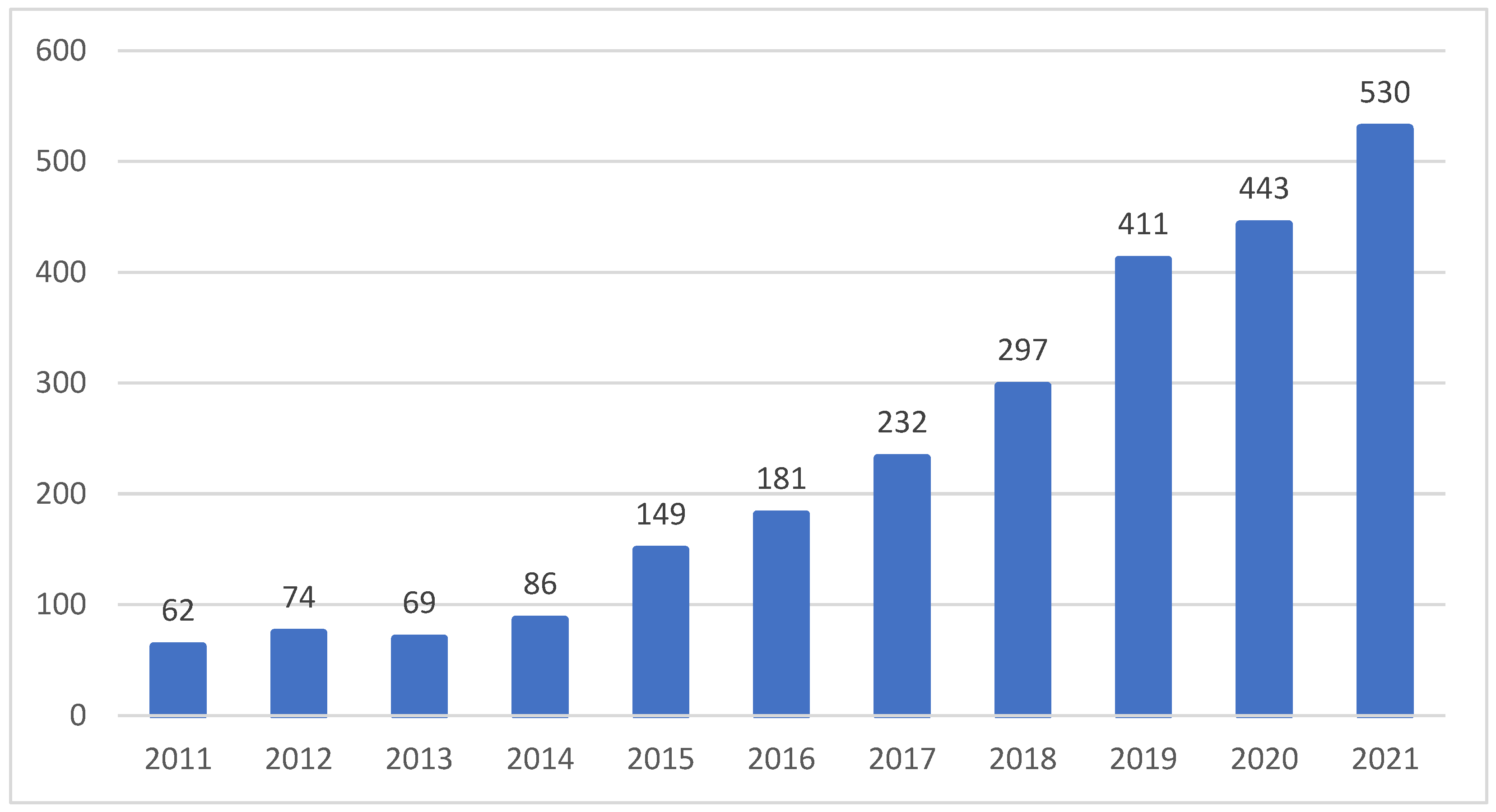
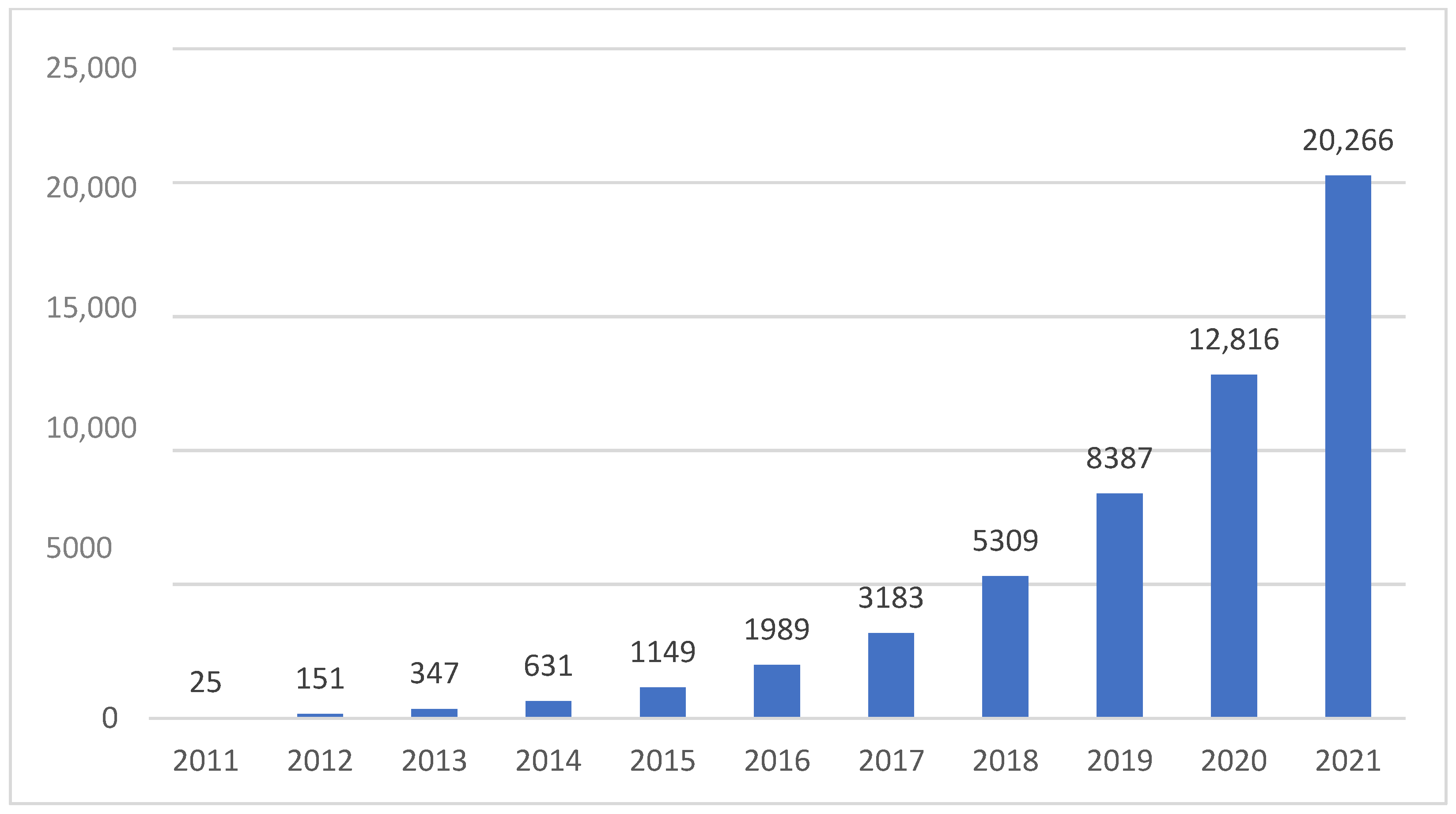
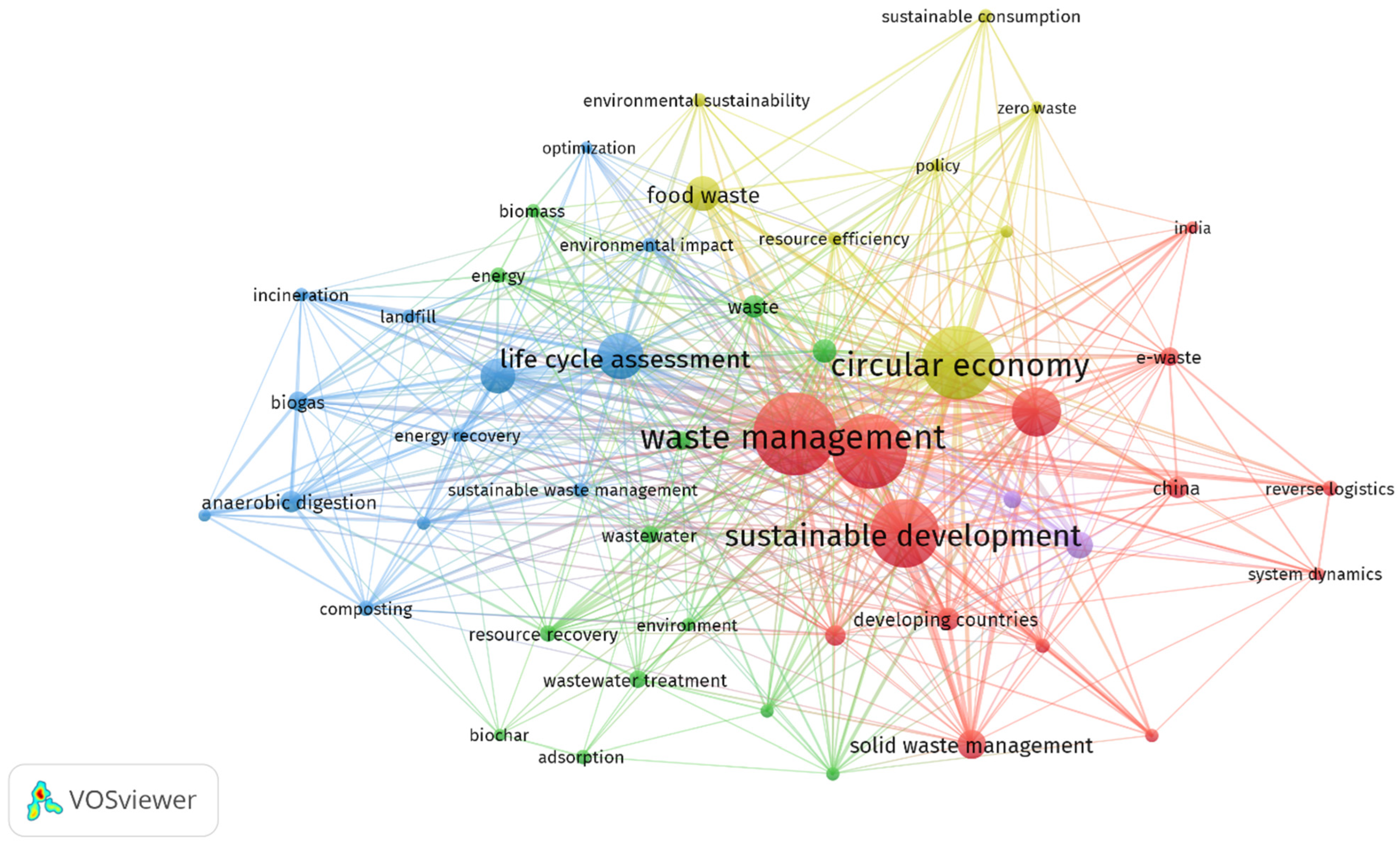
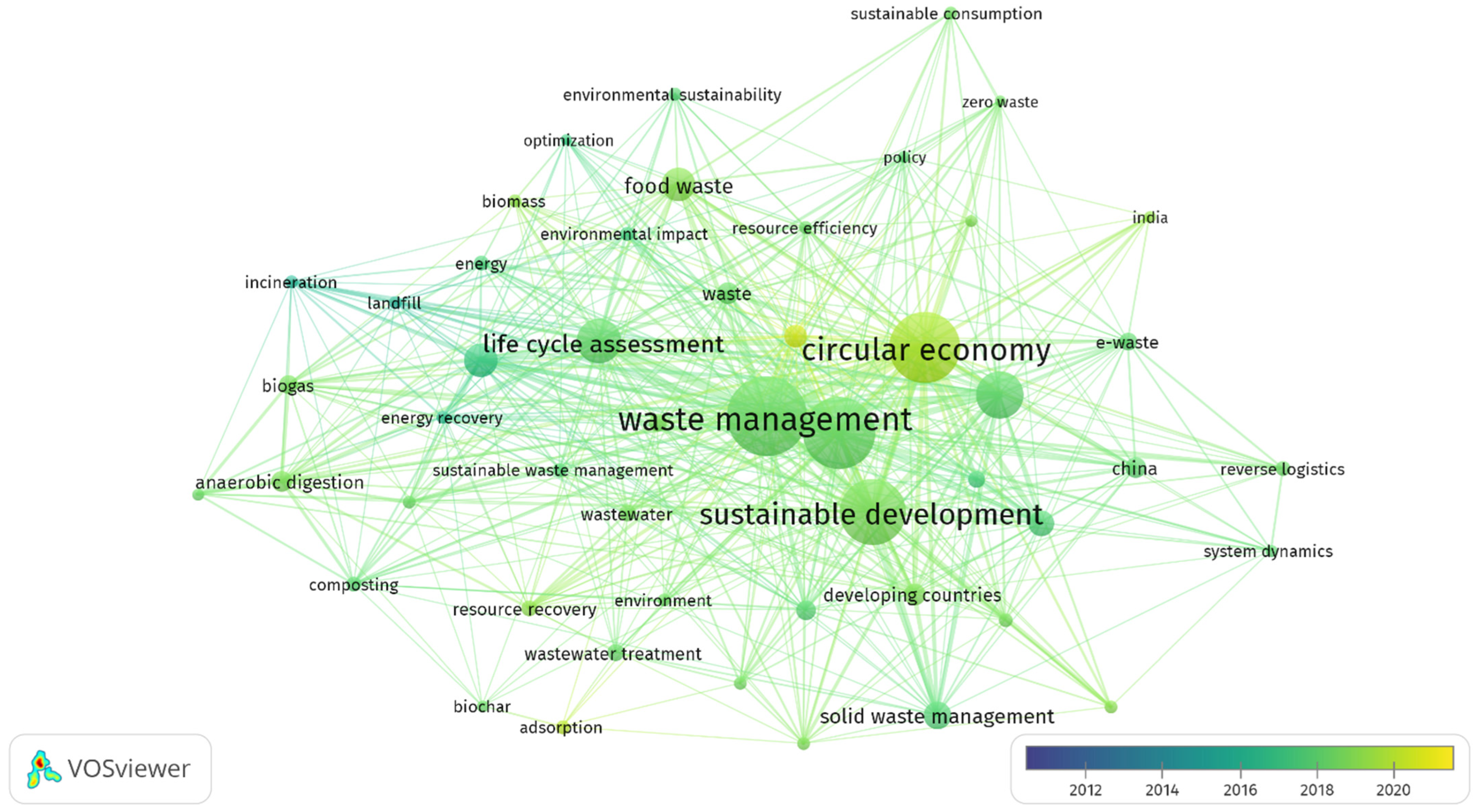
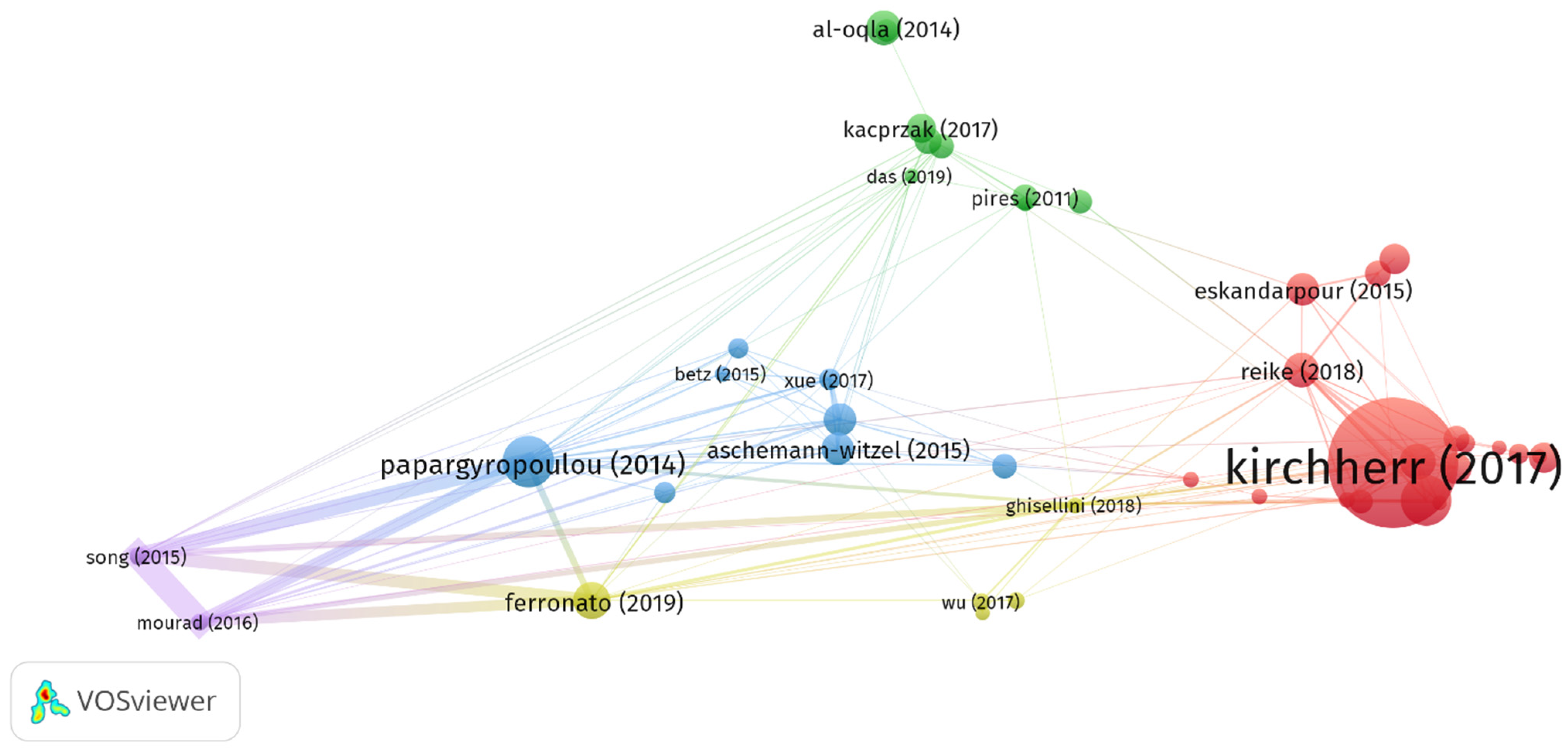
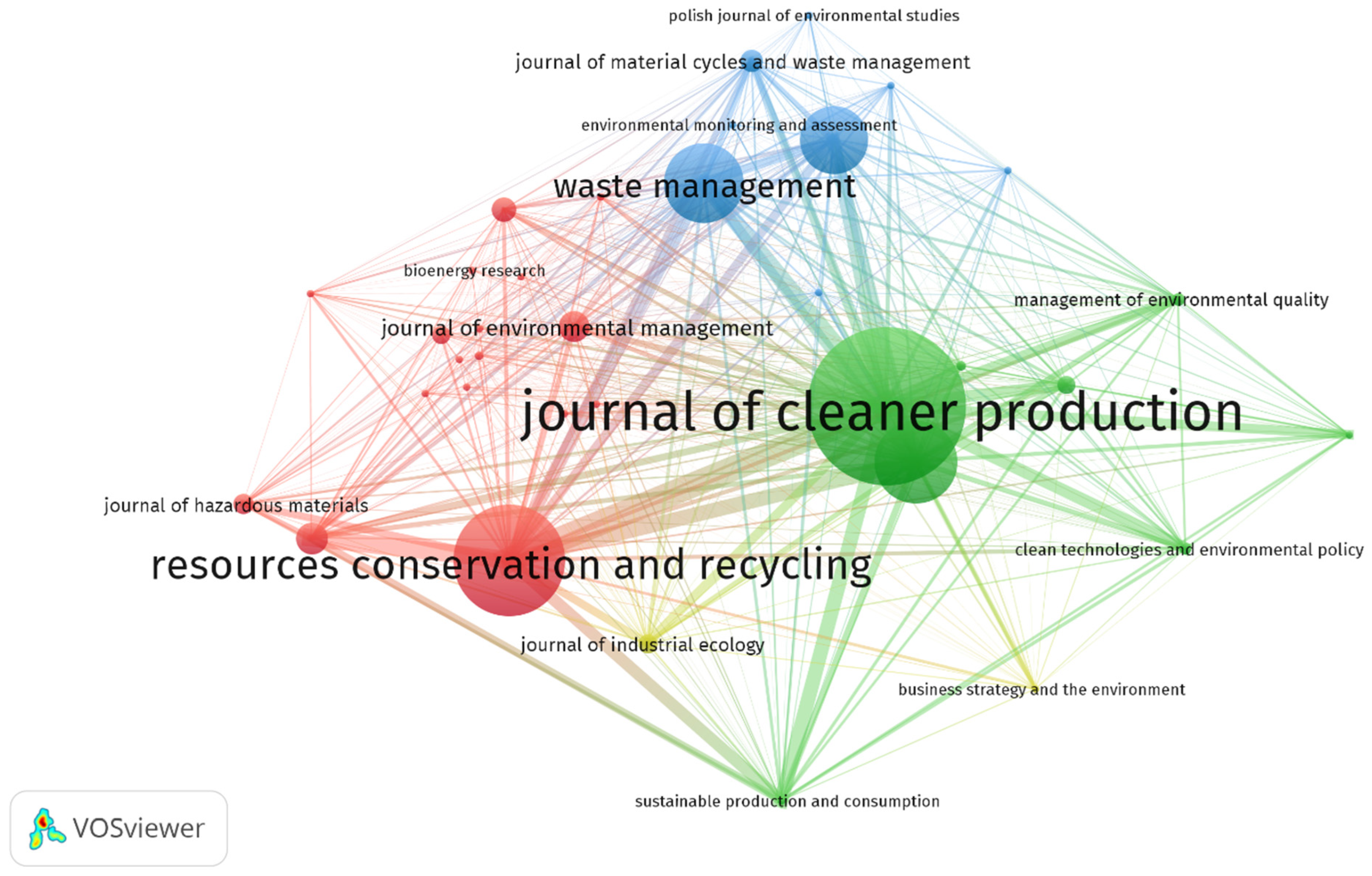
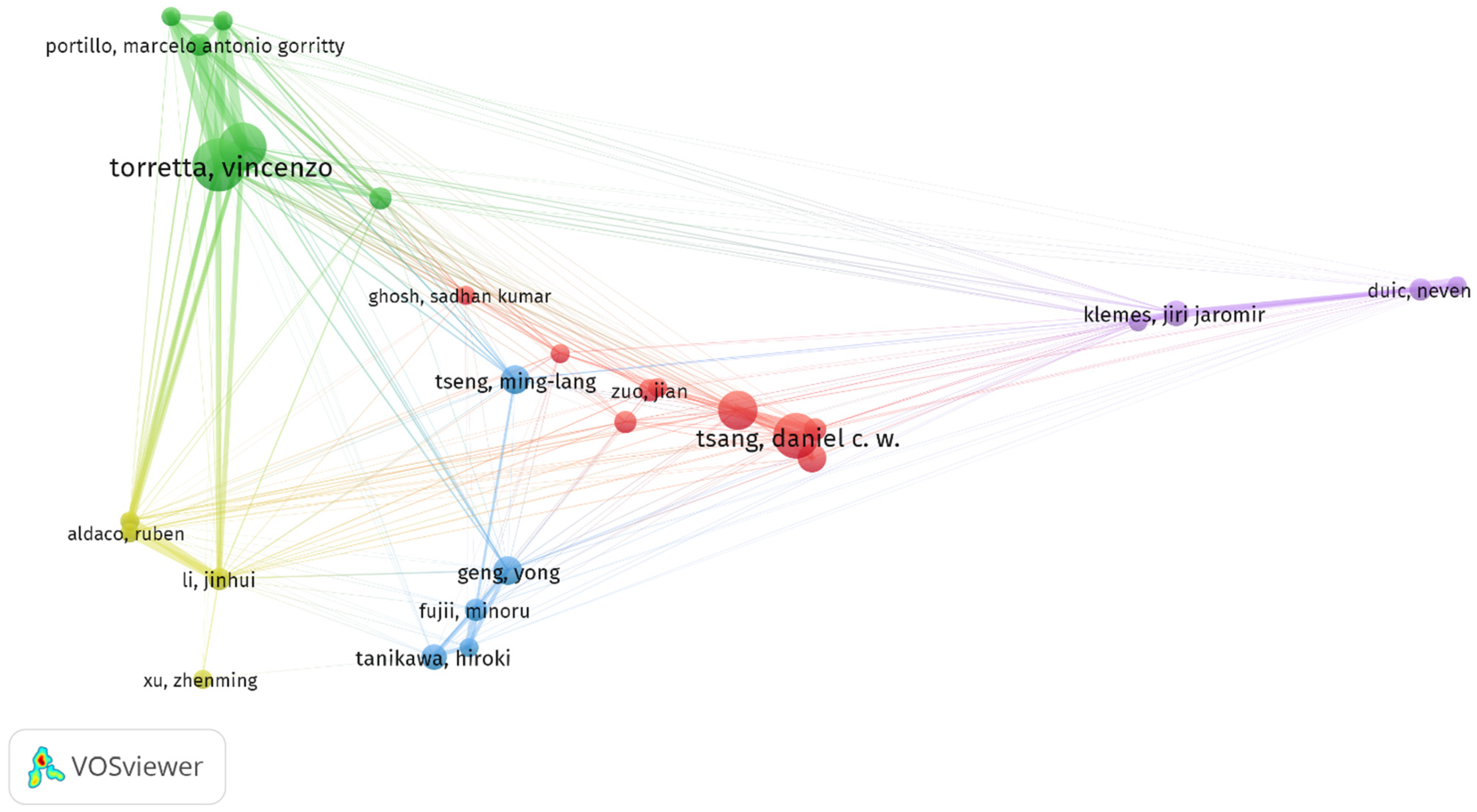
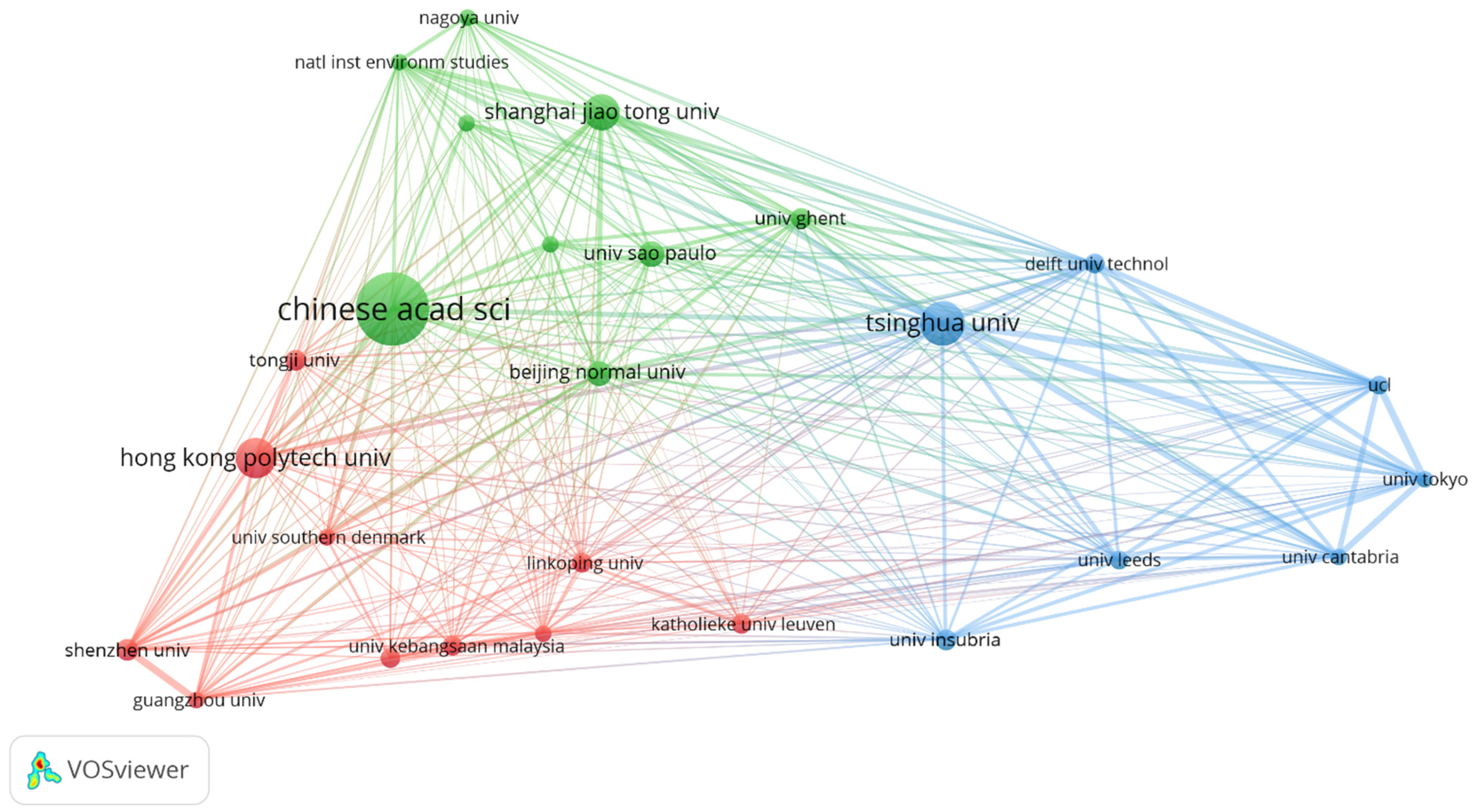
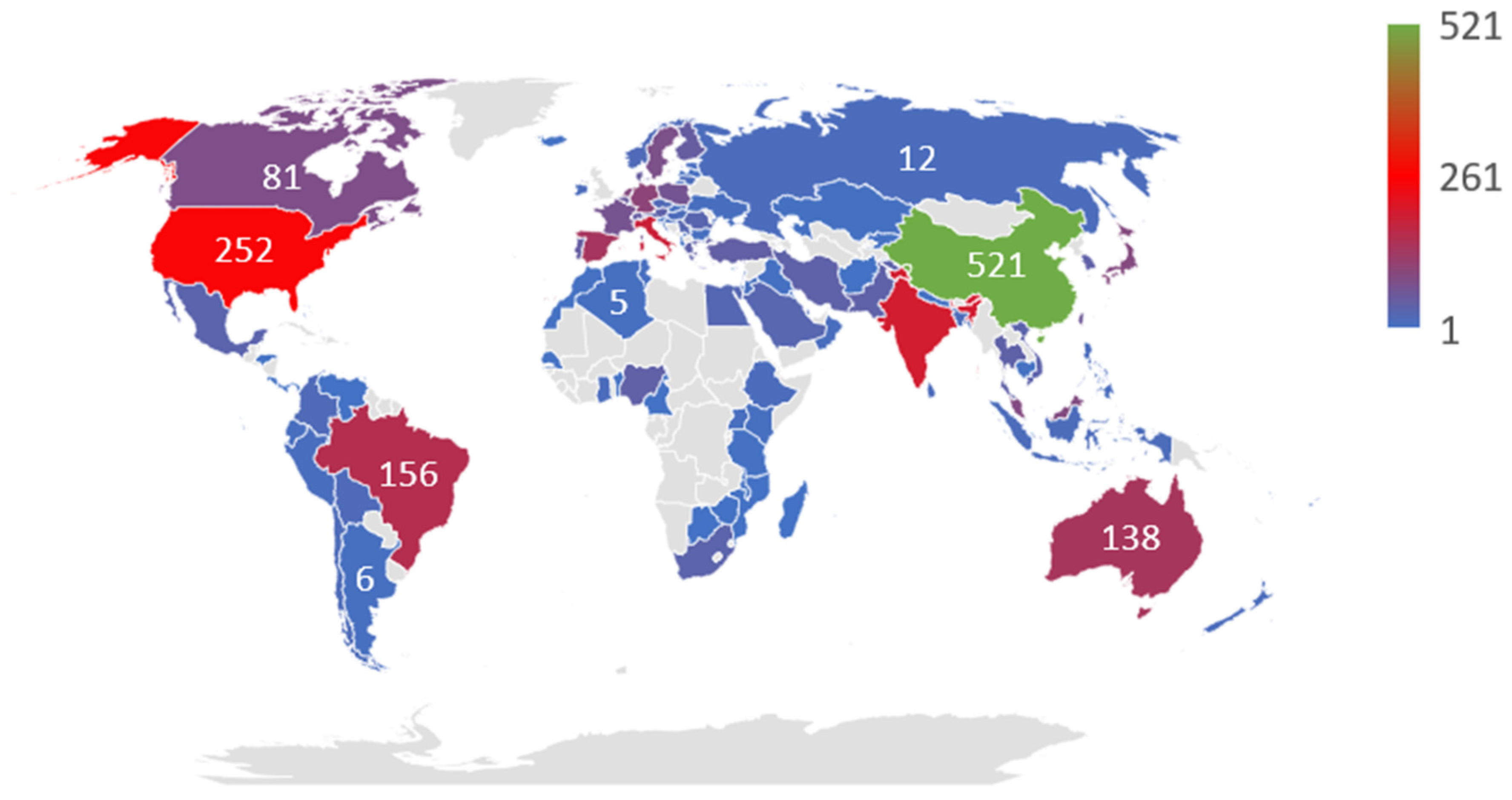
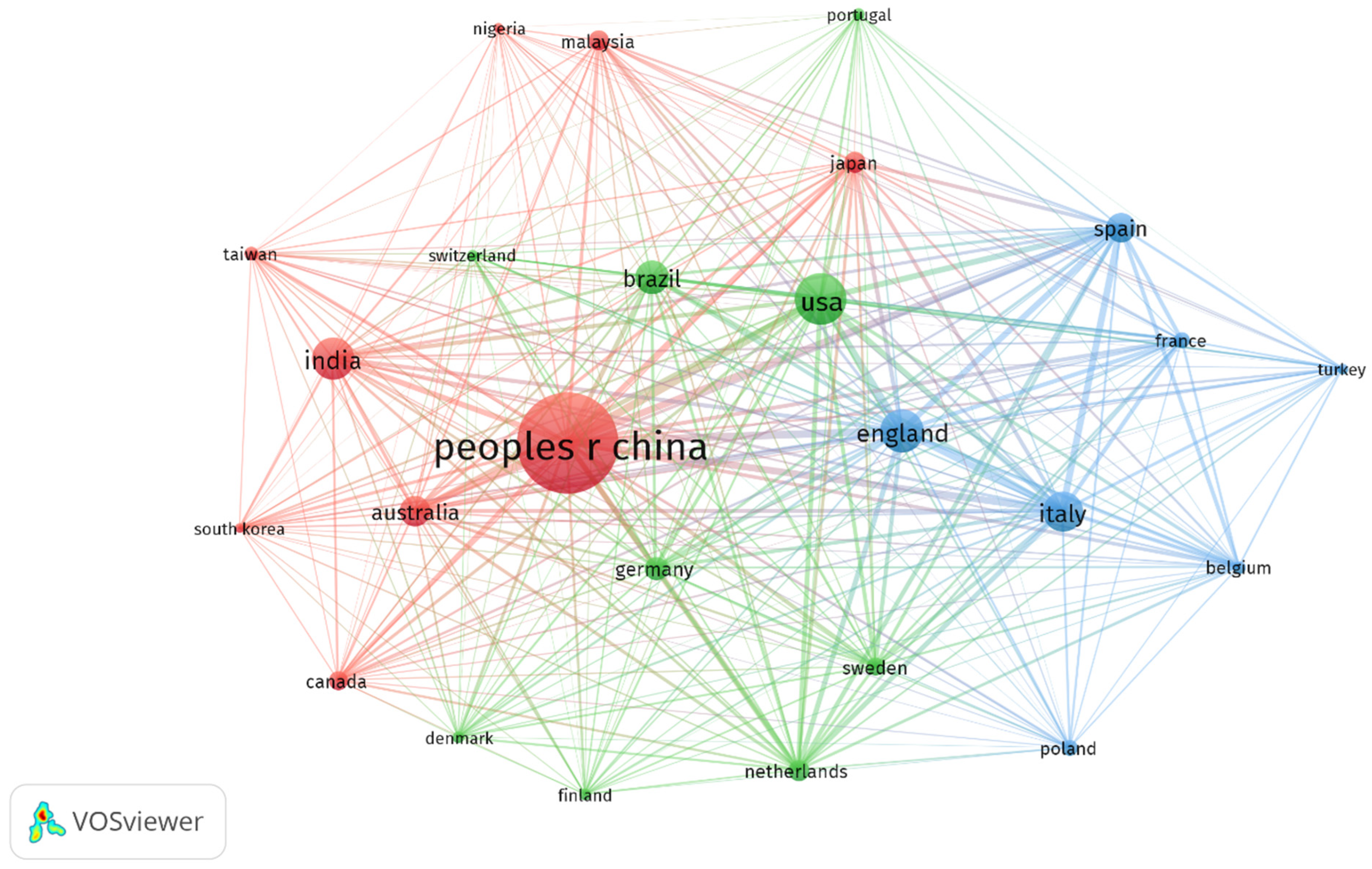
| Database | Web of Science (WoS) Core Collection |
|---|---|
| Title, Abstract, Keywords | ((TS = (“waste management*”)) OR (TS = (“zero waste*”)) AND (TS = (“sustainable consumption*”)) OR (TS = (“sustainable development*”))) |
| Document Types | Articles + Review + Letter + Note. |
| Years | 2011–2021 |
| Area of investigation | Environmental Sciences + Environmental Studies + Business + Economics |
| Sample | 2534 |
| Numbers of Citations | TP | % of | TC | % of | TC/TP |
|---|---|---|---|---|---|
| More than 1000 citations | 1 | 0.04% | 1297 | 2.39% | 1297.00 |
| 501–999 citations | 2 | 0.08% | 1029 | 1.90% | 514.50 |
| 101–500 citations | 80 | 3.17% | 13,528 | 24.94% | 169.10 |
| 51–100 citations | 174 | 6.89% | 11,969 | 22.06% | 68.79 |
| 11–50 citations | 906 | 35.90% | 21,164 | 39.01% | 23.36 |
| 1–10 citations | 1112 | 44.06% | 5266 | 9.71% | 4.74 |
| No citations | 249 | 9.87% | 0 | 0.00% | 0.00 |
| Total articles | 2534 | 100.00% | 54,253 | 100.00% |
| R | Keyword | O | TLS | R | Keyword | O | TLS |
|---|---|---|---|---|---|---|---|
| 1 | waste management | 301 | 339 | 26 | reverse logistics | 27 | 26 |
| 2 | sustainability | 261 | 266 | 27 | sustainable waste management | 26 | 24 |
| 3 | circular economy | 255 | 341 | 28 | environmental impact | 26 | 34 |
| 4 | sustainable development | 229 | 207 | 29 | material flow analysis | 25 | 37 |
| 5 | recycling | 143 | 175 | 30 | adsorption | 25 | 8 |
| 6 | life cycle assessment | 130 | 171 | 31 | waste-to-energy | 24 | 38 |
| 7 | food waste | 89 | 84 | 32 | construction and demolition waste | 24 | 31 |
| 8 | municipal solid waste | 87 | 111 | 33 | biomass | 24 | 26 |
| 9 | solid waste management | 68 | 72 | 34 | incineration | 23 | 42 |
| 10 | industrial ecology | 61 | 81 | 35 | environmental sustainability | 23 | 19 |
| 11 | sustainable development goals | 50 | 48 | 36 | cleaner production | 23 | 29 |
| 12 | developing countries | 49 | 83 | 37 | sustainable consumption | 22 | 17 |
| 13 | waste | 48 | 57 | 38 | reuse | 22 | 37 |
| 14 | anaerobic digestion | 46 | 68 | 39 | resource efficiency | 22 | 33 |
| 15 | China | 45 | 40 | 40 | landfill | 22 | 35 |
| 16 | solid waste | 41 | 47 | 41 | environment | 22 | 20 |
| 17 | biogas | 38 | 57 | 42 | energy recovery | 22 | 41 |
| 18 | e-waste | 36 | 45 | 43 | system dynamics | 21 | 19 |
| 19 | climate change | 35 | 35 | 44 | organic waste | 21 | 31 |
| 20 | wastewater treatment | 33 | 19 | 45 | biochar | 21 | 10 |
| 21 | wastewater | 33 | 41 | 46 | policy | 20 | 33 |
| 22 | industrial symbiosis | 33 | 50 | 47 | India | 20 | 22 |
| 23 | resource recovery | 32 | 44 | 48 | environmental management | 20 | 22 |
| 24 | energy | 29 | 36 | 49 | zero waste | 19 | 33 |
| 25 | composting | 28 | 42 | 50 | optimization | 19 | 22 |
| R | Name Article | Authors | Journal | Year | TC | CPY |
|---|---|---|---|---|---|---|
| 1 | Conceptualizing the circular economy: An analysis of 114 definitions [20] | Kirchherr, J; Reike, D and Hekkert, M | Resources Conservation and Recycling | 2017 | 1298 | 324.50 |
| 2 | The food waste hierarchy as a framework for the management of food surplus and food waste [98] | Papargyropoulou, E; Lozano, R; (…); bin Ujang, Z, | Journal of Cleaner Production | 2014 | 520 | 74.29 |
| 3 | A review of the circular economy in China: moving from rhetoric to implementation [100] | Su, B; Heshmati, A; (…); Yu, XM | Journal of Cleaner Production | 2013 | 509 | 63.63 |
| 4 | Sustainable management of coffee industry by-products and value addition-A review [107] | Murthy, PS and Naidu, MM | Resources Conservation and Recycling | 2012 | 408 | 45.33 |
| 5 | Waste Mismanagement in Developing Countries: A Review of Global Issues [99] | Ferronato, N and Torretta, V | International Journal of Environmental Research and Public Health | 2019 | 287 | 143.50 |
| 6 | How do scholars approach the circular economy? A systematic literature review [101] | Merli, R; Preziosi, M and Acampora, A | Journal of Cleaner Production | 2018 | 311 | 103.67 |
| 7 | Natural fiber reinforced polymer composites in industrial applications: feasibility of date palm fibers for sustainable automotive industry [102] | Al-Oqla, FM and Sapuan, SM | Journal of Cleaner Production | 2014 | 369 | 52.71 |
| 8 | The circular economy: New or Refurbished as CE 3.0?—Exploring Controversies in the Conceptualization of the Circular Economy through a Focus on History and Resource Value Retention Options [108] | Reike, D; Vermeulen, WJV and Witjes, S | Resources Conservation and Recycling | 2018 | 292 | 97.33 |
| 9 | Consumer-Related Food Waste: Causes and Potential for Action [109] | Aschemann-Witzel, J; de Hooge, I; (…); Oostindjer, M | Sustainability | 2015 | 312 | 52.00 |
| 10 | Drivers of food waste and their implications for sustainable policy development [110] | Thyberg, KL and Tonjes, DJ | Resources Conservation and Recycling | 2016 | 306 | 61.20 |
| 11 | Sustainable supply chain network design: An optimization-oriented review [111] | Eskandarpour, M; Dejax, P; (…); Peton, O | Omega-International Journal of Management Science | 2015 | 333 | 55.50 |
| 12 | The Relevance of Circular Economy Practices to the Sustainable Development Goals [112] | Schroeder, P; Anggraeni, K and Weber, U | Journal of Industrial Ecology | 2019 | 248 | 124.00 |
| 13 | Green supply chain initiatives among certified companies in Malaysia and environmental sustainability: Investigating the outcomes [113] | Eltayeb, TK; Zailani, S and Ramayah, T | Resources Conservation and Recycling | 2011 | 312 | 31.20 |
| 14 | Acid mine drainage: Prevention, treatment options, and resource recovery: A review [103] | Kefeni, KK; Msagati, TAM and Mamba, BB | Journal of Cleaner Production | 2017 | 274 | 68.50 |
| 15 | Sewage sludge disposal strategies for sustainable development [114] | Kacprzak, M; Neczaj, E; (…); Singh, BR | Environmental Research | 2017 | 286 | 71.50 |
| 16 | Sustainability of using composting and vermicomposting technologies for organic solid waste biotransformation: recent overview, greenhouse gases emissions and economic analysis [104] | Lim, SL; Lee, LH and Wu, TY | Journal of Cleaner Production | 2016 | 271 | 54.20 |
| 17 | Solid waste management in European countries: A review of systems analysis techniques [115] | Pires, A; Martinho, G and Chang, NB | Journal of Environmental Management | 2011 | 285 | 28.50 |
| 18 | Towards a more Circular Economy: Proposing a framework linking sustainable public procurement and sustainable business models [116] | Witjes, S and Lozano, R | Resources Conservation and Recycling | 2016 | 249 | 49.80 |
| 19 | A literature review and perspectives in reverse logistics [117] | Agrawal, S; Singh, RK and Murtaza, Q | Resources Conservation and Recycling | 2015 | 259 | 43.17 |
| 20 | The role of life cycle assessment in supporting sustainable agri-food systems: A review of the challenges [105] | Notarnicola, B; Sala, S; (…); Sonesson, U | Journal of Cleaner Production | 2017 | 231 | 57.75 |
| 21 | A review on technological options of waste to energy for effective management of municipal solid waste [118] | Kumar, A and Samadder, SR | Waste Management | 2017 | 211 | 52.75 |
| 22 | The crucial role of Waste-to-Energy technologies in enhanced landfill mining: a technology review [106] | Bosmans, A; Vanderreydt, I; (…); Helsen, L | Journal of Cleaner Production | 2013 | 244 | 30.50 |
| 23 | Circular Economy Policies in China and Europe [119] | McDowall, W; Geng, Y; (…); Domenech, T | Journal of Industrial Ecology | 2017 | 216 | 54.00 |
| 24 | Utilization of agricultural and forest industry waste and residues in natural fiber-polymer composites: A review [120] | Vaisanen, T; Haapala, A; (…); Tomppo, L | Waste Management | 2016 | 218 | 43.60 |
| 25 | Missing Food, Missing Data? A Critical Review of Global Food Losses and Food Waste Data [121] | Xue, L; Liu, G; (…); Cheng, SK | Environmental Science and Technology | 2017 | 194 | 48.50 |
| R | Journal | Editorial | IF | IF5 | Q | TP | TC | TC/TP | >200 | >100 | >50 | >25 | H |
|---|---|---|---|---|---|---|---|---|---|---|---|---|---|
| 1 | Journal of Cleaner Production | Elsevier | 11.07 | 11.01 | Q1 | 443 | 15,573 | 35.15 | 8 | 25 | 58 | 90 | 73 |
| 2 | Resources Conservation and Recycling | Elsevier | 13.71 | 13.54 | Q1 | 302 | 11,619 | 38.47 | 7 | 11 | 42 | 70 | 60 |
| 3 | Waste Management | Elsevier | 8.81 | 9.41 | Q1 | 208 | 6114 | 29.39 | 2 | 11 | 26 | 37 | 43 |
| 4 | Waste Management Research | SAGE | 4.43 | 4.27 | Q2 | 173 | 2257 | 13.05 | 1 | 1 | 4 | 13 | 25 |
| 5 | Sustainability | MDPI | 3.88 | 4.08 | Q2 | 216 | 2513 | 11.63 | 1 | 0 | 4 | 16 | 23 |
| 6 | Journal of Environmental Management | Elsevier | 8.91 | 5.54 | Q1 | 74 | 1522 | 20.57 | 1 | 1 | 5 | 7 | 23 |
| 7 | Science of the Total Environment | Elsevier | 10.75 | 10.23 | Q1 | 77 | 995 | 12.92 | 0 | 0 | 3 | 9 | 21 |
| 8 | Journal of Hazardous Materials | Elsevier | 14.22 | 12.98 | Q1 | 45 | 973 | 21.62 | 0 | 3 | 2 | 4 | 19 |
| 9 | Journal of Industrial Ecology | Wiley Online Library | 7.20 | 7.94 | Q1 | 44 | 1304 | 29.64 | 2 | 1 | 5 | 5 | 17 |
| 10 | Journal of Material Cycles and Waste Management | Springer | 3.57 | 3.45 | Q3 | 52 | 745 | 14.33 | 0 | 0 | 0 | 8 | 16 |
| 11 | Waste and Biomass Valorization | Springer | 3.44 | 3.57 | Q3 | 41 | 571 | 13.93 | 0 | 0 | 2 | 6 | 16 |
| 12 | Environmental Science and Pollution Research | Elsevier | 5.19 | 5.05 | Q2 | 58 | 444 | 7.66 | 0 | 0 | 1 | 3 | 15 |
| 13 | Environmental Technology | Taylor and Francis | 3.47 | 3.18 | Q3 | 42 | 346 | 8.24 | 0 | 0 | 0 | 2 | 12 |
| 14 | Clean Technologies and Environmental Policy | Springer | 4.70 | 3.98 | Q2 | 26 | 422 | 16.23 | 0 | 1 | 1 | 3 | 12 |
| 15 | Chemosphere | Elsevier | 8,94 | 8.52 | Q1 | 18 | 283 | 15.72 | 0 | 0 | 1 | 2 | 12 |
| 16 | Environmental Science and Technology | ACS Publications | 11.35 | 12.15 | Q1 | 16 | 549 | 34.31 | 0 | 1 | 1 | 4 | 12 |
| 17 | International Journal of Environmental Research and Public Health | MDPI | 4.61 | 4.79 | Q2 | 20 | 563 | 28.15 | 1 | 0 | 2 | 1 | 11 |
| 18 | Sustainable Production and Consumption | Elsevier | 8.92 | 8.42 | Q1 | 16 | 176 | 11.00 | 0 | 0 | 0 | 2 | 11 |
| 19 | Bioenergy Research | Springer | 3.85 | 3.49 | Q2 | 17 | 185 | 10.88 | 0 | 0 | 0 | 0 | 10 |
| 20 | Business Strategy and The Environment | Wiley Online Library | 10.80 | 11.60 | Q1 | 14 | 186 | 13.29 | 0 | 0 | 0 | 3 | 10 |
| 21 | Ecological Indicators | Elsevier | 6.26 | 6.64 | Q1 | 14 | 195 | 13.93 | 0 | 0 | 0 | 3 | 10 |
| 22 | Management of Environmental Quality | Emerald | - | - | - | 29 | 147 | 5.07 | 0 | 0 | 0 | 1 | 9 |
| 23 | Environmental Technology Innovation | Elsevier | 7.75 | 7.37 | Q1 | 16 | 76 | 4.75 | 0 | 0 | 0 | 0 | 9 |
| 24 | Water Science and Technology | MDPI | 2.43 | 2.52 | Q3 | 16 | 156 | 9.75 | 0 | 0 | 1 | 0 | 8 |
| 25 | Environmental Science-Water Research Technology | Royal Society of Chemistry | 5.81 | 6.02 | Q2 | 14 | 119 | 8.50 | 0 | 0 | 0 | 2 | 7 |
| R | Author | Institution * | TP | TC | TC/TA | >200 | >100 | >50 | >25 | H |
|---|---|---|---|---|---|---|---|---|---|---|
| 1 | Tsang, Daniel | Zhejiang University | 15 | 277 | 18.47 | 0 | 0 | 0 | 3 | 11 |
| 2 | Poon, Chi Sun | Hong Kong Polytechnic University | 13 | 386 | 29.69 | 0 | 0 | 3 | 3 | 10 |
| 3 | Geng, Yong | Shandong University | 10 | 1068 | 106.80 | 2 | 0 | 2 | 2 | 10 |
| 4 | Torretta, Vincenzo | University of Insubria | 18 | 543 | 30.17 | 1 | 0 | 0 | 1 | 9 |
| 5 | Ferronato Navarro | University of Insubria | 16 | 496 | 31.00 | 1 | 0 | 0 | 1 | 8 |
| 6 | Wang, Yue | Southwest University, China | 12 | 175 | 14.58 | 0 | 0 | 1 | 2 | 8 |
| 7 | Tseng, Ming-Lang | De La Salle University | 11 | 226 | 20.55 | 0 | 0 | 2 | 0 | 8 |
| 8 | Tanikawa, Hiroki | Fujita Health University | 8 | 123 | 15.38 | 0 | 0 | 0 | 1 | 8 |
| 9 | Singh, Amol | Indian Institute of Management Rohtak | 13 | 225 | 17.31 | 0 | 0 | 3 | 0 | 7 |
| 10 | Wang, Chao | Southern University of Science and Technology | 12 | 124 | 10.33 | 0 | 0 | 0 | 1 | 7 |
| 11 | Portillo, Marcelo | Universidad Mayor de San Andres | 10 | 190 | 19.00 | 0 | 0 | 1 | 0 | 7 |
| 12 | Kumar, Atul | Indian Institute of Technology System | 9 | 348 | 38.67 | 1 | 0 | 0 | 3 | 7 |
| 13 | Li, Jinhui | Tsinghua University | 9 | 403 | 44.78 | 0 | 1 | 1 | 3 | 7 |
| 14 | Ok, Yong Sik | Korea University | 9 | 103 | 11.44 | 0 | 0 | 1 | 0 | 7 |
| 15 | Duic, Neven | University of Zagreb | 7 | 158 | 22.57 | 0 | 0 | 3 | 0 | 7 |
| 16 | Lizarazu, Edith | Universidad Mayor de San Andres | 7 | 100 | 14.29 | 0 | 0 | 0 | 1 | 7 |
| 17 | Klemes, Jiri | Zhejiang University | 8 | 177 | 22.13 | 1 | 0 | 0 | 1 | 6 |
| 18 | Liu, Yi | Jiangxi University of Finance and Economics | 8 | 123 | 15.38 | 0 | 0 | 1 | 1 | 6 |
| 19 | Zhang, Yong | Southeast University—China | 8 | 119 | 14.88 | 0 | 0 | 0 | 2 | 6 |
| 20 | Fujii, Minoru | National Institute for Environmental Studies | 7 | 156 | 22.29 | 0 | 0 | 3 | 0 | 6 |
| 21 | Li, Yan | Shandong University | 7 | 105 | 15.00 | 0 | 0 | 0 | 2 | 6 |
| 22 | Li, Xin | Hunan University | 7 | 193 | 27.57 | 0 | 0 | 2 | 1 | 6 |
| 23 | Singh, Seema | Joint BioEnergy Institute | 9 | 257 | 28.56 | 0 | 1 | 1 | 1 | 5 |
| 24 | Aldaco, Ruben | Universidad de Cantabria | 8 | 173 | 21.63 | 0 | 0 | 1 | 2 | 5 |
| 25 | Margallo, Maria | Universidad de Cantabria | 8 | 173 | 21.63 | 0 | 0 | 1 | 2 | 5 |
| R | Institution | Country | TP | TC | TC/TP | >200 | >100 | >50 | >25 | H |
|---|---|---|---|---|---|---|---|---|---|---|
| 1 | Chinese Academy of Sciences | China | 67 | 1852 | 27.64 | 1 | 1 | 6 | 7 | 25 |
| 2 | Hong Kong Polytechnic University | China | 33 | 987 | 29.91 | 0 | 3 | 3 | 5 | 21 |
| 3 | Indian Institute of Technology System IIT System | India | 42 | 1007 | 23.98 | 1 | 1 | 3 | 7 | 18 |
| 4 | Shanghai Jiao Tong University | China | 29 | 834 | 28.76 | 1 | 0 | 3 | 6 | 17 |
| 5 | Tsinghua University | China | 36 | 790 | 21.94 | 0 | 1 | 3 | 5 | 16 |
| 6 | Wageningen University Research | The Netherlands | 21 | 1455 | 69.29 | 2 | 4 | 4 | 2 | 15 |
| 7 | Council of Scientific Industrial Research CSIR | India | 27 | 884 | 32.74 | 1 | 2 | 3 | 2 | 14 |
| 8 | Beijing Normal University | China | 20 | 501 | 25.05 | 0 | 1 | 2 | 4 | 14 |
| 9 | State University System of Florida | United States | 18 | 906 | 50.33 | 1 | 2 | 3 | 5 | 14 |
| 10 | Ghent University | Belgium | 17 | 696 | 40.94 | 0 | 3 | 2 | 2 | 14 |
| 11 | University of London | England | 23 | 778 | 33.83 | 1 | 1 | 3 | 5 | 13 |
| 12 | Shenzhen University | China | 18 | 676 | 37.56 | 0 | 1 | 5 | 3 | 13 |
| 13 | National Institute for Environmental Studies Japan | Japan | 17 | 491 | 28.88 | 0 | 1 | 0 | 4 | 13 |
| 14 | National Institute of Technology NIT System | Namibia | 23 | 480 | 20.87 | 0 | 2 | 2 | 2 | 12 |
| 15 | Universidade de Sao Paulo | Brazil | 21 | 362 | 17.24 | 0 | 1 | 0 | 3 | 12 |
| 16 | Delft University of Technology | The Netherlands | 16 | 385 | 24.06 | 0 | 0 | 2 | 3 | 12 |
| 17 | Ku Leuven | Belgium | 18 | 656 | 36.44 | 1 | 2 | 1 | 3 | 11 |
| 18 | Tongji University | China | 17 | 147 | 8.65 | 0 | 0 | 0 | 1 | 11 |
| 19 | University of California System | United States | 18 | 333 | 18.50 | 0 | 1 | 0 | 1 | 10 |
| 20 | Universiti Malaya | Malaysia | 17 | 370 | 21.76 | 0 | 0 | 2 | 3 | 10 |
| 21 | University of Insubria | Italy | 20 | 545 | 27.25 | 1 | 0 | 1 | 1 | 9 |
| 22 | Centre National de la Recherche Scientifique | France | 17 | 588 | 34.59 | 1 | 1 | 0 | 2 | 9 |
| 23 | Universiti Kebangsaan Malaysia | Malaysia | 17 | 217 | 12.76 | 0 | 0 | 1 | 1 | 9 |
| 24 | Egyptian Knowledge Bank EKB | Egypt | 20 | 106 | 5.30 | 0 | 0 | 0 | 0 | 8 |
| 25 | University of Leeds | England | 18 | 140 | 7.77 | 0 | 0 | 0 | 0 | 7 |
| R | Region | Continent | TP | TC | TC/TP | >200 | >100 | >50 | >25 | H |
|---|---|---|---|---|---|---|---|---|---|---|
| 1 | China | Asia | 521 | 10,351 | 19.87 | 2 | 12 | 45 | 56 | 59 |
| 2 | United States | America | 252 | 6233 | 24.73 | 2 | 10 | 24 | 38 | 45 |
| 3 | Italy | Europe | 187 | 4787 | 25.60 | 3 | 5 | 20 | 24 | 43 |
| 4 | India | Asia | 198 | 4575 | 23.11 | 3 | 7 | 16 | 25 | 42 |
| 5 | England | Europe | 202 | 5321 | 26.34 | 4 | 7 | 15 | 27 | 41 |
| 6 | Australia | Oceania | 138 | 3145 | 22.79 | 0 | 4 | 19 | 14 | 36 |
| 7 | Brazil | America | 156 | 2684 | 17.21 | 0 | 4 | 11 | 21 | 34 |
| 8 | Netherlands | Europe | 91 | 5537 | 60.85 | 7 | 6 | 10 | 15 | 33 |
| 9 | Germany | Europe | 103 | 2702 | 26.23 | 1 | 6 | 8 | 10 | 30 |
| 10 | Spain | Europe | 137 | 2373 | 17.32 | 1 | 1 | 7 | 17 | 29 |
| 11 | Malaysia | Asia | 88 | 3230 | 36.70 | 4 | 2 | 8 | 15 | 29 |
| 12 | Sweden | Europe | 79 | 2382 | 30.15 | 2 | 3 | 7 | 12 | 27 |
| 13 | Denmark | Europe | 51 | 1915 | 37.55 | 1 | 4 | 6 | 10 | 26 |
| 14 | Canada | America | 81 | 1310 | 16.17 | 0 | 1 | 5 | 14 | 25 |
| 15 | Belgium | Europe | 54 | 1657 | 30.69 | 1 | 3 | 6 | 9 | 23 |
| 16 | Japan | Asia | 91 | 1458 | 16.02 | 0 | 1 | 2 | 13 | 23 |
| 17 | France | Europe | 70 | 1723 | 24.61 | 1 | 3 | 6 | 7 | 23 |
| 18 | Taiwan | Asia | 59 | 1211 | 20.53 | 0 | 1 | 6 | 7 | 22 |
| 19 | Poland | Europe | 68 | 1138 | 16.74 | 1 | 0 | 2 | 11 | 21 |
| 20 | Finland | Europe | 48 | 1325 | 27.60 | 1 | 2 | 6 | 6 | 20 |
| 21 | Turkey | Europe/Asia | 44 | 945 | 21.48 | 0 | 1 | 5 | 5 | 20 |
| 22 | Portugal | Europe | 47 | 1532 | 32.60 | 1 | 3 | 7 | 3 | 19 |
| 23 | Switzerland | Europe | 47 | 945 | 20.11 | 0 | 2 | 1 | 9 | 19 |
| 24 | South Korea | Asia | 40 | 1249 | 31.23 | 1 | 1 | 3 | 5 | 19 |
| 25 | Nigeria | Africa | 40 | 384 | 9.60 | 0 | 0 | 0 | 6 | 13 |
Publisher’s Note: MDPI stays neutral with regard to jurisdictional claims in published maps and institutional affiliations. |
© 2022 by the authors. Licensee MDPI, Basel, Switzerland. This article is an open access article distributed under the terms and conditions of the Creative Commons Attribution (CC BY) license (https://creativecommons.org/licenses/by/4.0/).
Share and Cite
Valenzuela-Fernández, L.; Escobar-Farfán, M. Zero-Waste Management and Sustainable Consumption: A Comprehensive Bibliometric Mapping Analysis. Sustainability 2022, 14, 16269. https://doi.org/10.3390/su142316269
Valenzuela-Fernández L, Escobar-Farfán M. Zero-Waste Management and Sustainable Consumption: A Comprehensive Bibliometric Mapping Analysis. Sustainability. 2022; 14(23):16269. https://doi.org/10.3390/su142316269
Chicago/Turabian StyleValenzuela-Fernández, Leslier, and Manuel Escobar-Farfán. 2022. "Zero-Waste Management and Sustainable Consumption: A Comprehensive Bibliometric Mapping Analysis" Sustainability 14, no. 23: 16269. https://doi.org/10.3390/su142316269
APA StyleValenzuela-Fernández, L., & Escobar-Farfán, M. (2022). Zero-Waste Management and Sustainable Consumption: A Comprehensive Bibliometric Mapping Analysis. Sustainability, 14(23), 16269. https://doi.org/10.3390/su142316269







